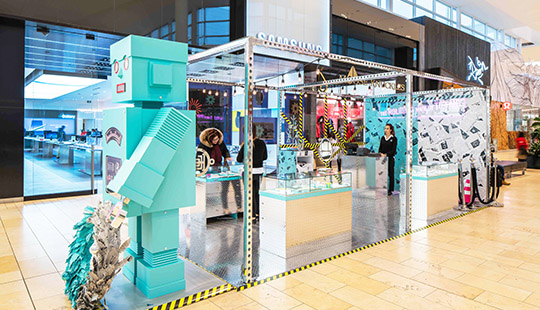Strategic partnerships: Brand partnerships taking a new turn
January 13, 2020In today’s world, brand partnerships are taking on new permutations, from popup extravaganzas to digital flyer programs – all in the hopes of gaining market share, keeping existing customers, or reaching untapped markets, among other drivers.
BY DENISE DEVEAU

Both online and in-store retailers are creating new partnership opportunities that are crossing traditional boundaries. For eCommerce pure plays, retail partnerships are becoming an effective way to bring their customer or service to life. For brick and mortar, partnerships can help them tap into lucrative retail channels and increase foot traffic in the process.
There are several factors behind the growing appetite for brand partnerships, says Patrick Rodmell, President of Rodmell & Company Inc. in Toronto. “One is necessity based in a changing business dynamic. With eCommerce as a new channel to buy, many retailers find they are dealing with too much physical space, so looking to sub-lease square footage.”
The second is leveraging the power of complementary offerings with other brands to appeal to a new customer segment. “Adding a new service can bring in new kinds of customers or draw current customers in more often to spend more… or both.”
A number of larger stores are now partnering with foodservice brands (e.g. Home Depot and Subway, Longo’s and Starbucks) to enhance the shopping experience. “By bringing in a complementary brand, retailers can get the halo effect of positive brand equity,” Rodmell explains.
These types of partnerships are especially important where a retailer lacks the category expertise to do it themselves. “A Home Depot doesn’t want to run foodservice operations. They don’t have that credibility.”
Alternatively, a brand partnership can help to establish credibility for future diversification. Loblaw tested the waters with prepared foods by partnering with Movenpick years ago. “That was a strategic move for Loblaw to gain credibility in the category. They ‘borrowed’ the equity of Movenpick and transferred that to their brand when Movenpick left.”
Retailers are even exploring innovative partnerships with services like Spotify to create specific music lists for in-store customers. “It’s not accretive to the commercial business, but it gets the brand into the lifestyle of the customer,” Rodmell says.
Mall makeovers
Brand partnerships in shopping centres have evolved considerably from what they were in the past, says Mina Barbuto, Yorkdale Marketing Director, Yorkdale Shopping Centre. “If you look at eCommerce, there’s an appetite for brands to have the customer engagement they can’t have online. Partnerships are a way to do that, because they can deliver immersive experiences and activations.”
There have been countless partnership events at Yorkdale that run from high-end popup shops and the Tiffany Tree, to its CONCEPT space dedicated to popup activities, where consumers can experience products from newcomers on the retail scene.
“Where we have seen the biggest evolution is activations and partnerships through collaborations like designers OVO and Canada Goose, Knix and Nordstrom, LCBO and Johnny Walker and Moet-Hennesy. We’re even seeing Amazon do popups for specific brands to encourage people to sign up for services. We expect to see a lot more of that.”

Lisa Hutcheson, Managing Partner with J.C. Williams Group, says partnerships are now replacing the old cart system. “That was the first evolution. Now popups have gotten a lot more sophisticated.”
In-store popups not only provide a revenue opportunity, they create buzz around new brands and drive fresh traffic, she adds. “It’s a great way for Nordstrom to have something new and fresh taking up real estate that normally wouldn’t be as popular. The popup concept can also be beneficial to shopping centres because a retailer can try out the location for a few weeks or months to test the market before committing to a storefront.”
In some cases you don’t need to have an actual product, she adds. “An eCommerce retailer may just want to build brand awareness. In an online world there is still a need for brick and mortar to enjoy that experience.”
The digital divide
In-person engagement isn’t the only route for retail partnerships. Digital co-op is transforming in response to a shopper-led digital revolution, says John Fanous, Business Lead, Retail & Shopper Marketing for @Google Canada.
“Shoppers went digital before retailers and brands did. Even the most mundane things people buy—toothbrushes, deodorant, shower curtains— are hyper-researched online.”
More and more vendors are now switching to digital coop marketing to drive purchases. “Omnichannel or eCommerce retailers offer some things that vendors can’t,” Fanous explains.
“They have about 50 times the data of vendors. Their eCommerce infrastructure allows them to do certain kinds of digital marketing that vendors can’t gain access to. Retailers also have tracking capabilities to understand how many go online.”
In the past, brand decisions ended when they decided on an end cap and/ or a front-page spot on a flyer. “Now we’re seeing merchants amplifying the message/value proposition on digital channels, such as online videos featuring preferred products to create more connection moments with shoppers.”
Beginner basics
While there are partnership opportunities aplenty to be had, a successful one is rooted in some important principles, Rodmell says.
First determine the business goal. “Put aside the real estate issue—that’s a tactical thing. Do you want to grow your existing segment, attract a new one, or simply keep the ones you have in the face of growing competition?”
Second, does the partner share the same values? Even when products may seem disparate, the common factor to look for is target audience. A high-end grocery store with a premium branded café makes sense. Partnering with a discount brand would not because the brands would be too disparate, Rodmell notes. “Your really do get judged by the company you keep.”
While brand partnerships may not be new to retailer circles, the experiential aspect will continue to be a focus for some time to come, he adds. “There will only be an acceleration in partnerships going forward. This is not a fad. It’s a trend that will last a very long time.”



